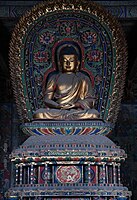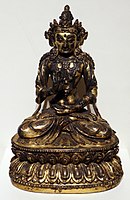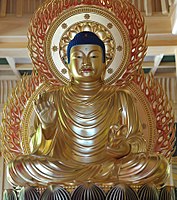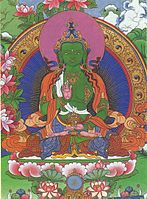Amoghasiddhi
(romaji: Fukūjōju Butsu)
(UNGEGN: Âmoŭkhôsĕtthĭ)
(RR: Bulgongseongchwi Bosal)
Үйлс бүтээгч
(SASM/GNC: Tegüs nögcigsen)
Phraamoksitthiphuttha
Wylie: don yod grub pa
THL: dönyö drubpa
 Religion portal
Religion portalAmoghasiddhi (Devanagari: अमोघसिद्धि) is one of the Five Wisdom Buddhas of the Mahayana and Vajrayana tradition of Buddhism. He is associated with the accomplishment of the Buddhist path and of the destruction of the poison of envy. His name means Unfailing Accomplishment. His consort is Tara, meaning Liberator and his mounts are garudas. He belongs to the family of karma whose family symbol is the double vajra.[1][2]
Characteristics
Amoghasiddhi is associated with the conceptual (Skt: samskara) skandha or the conceptual mind (as opposed to the non-conceptual or sensational mind). His action towards the promotion of Buddhist paths is the pacification of evils. This is symbolised by Amoghasiddhi's symbol, the moon. He gestures in the mudra of fearlessness, symbolising his and his devotees' fearlessness towards the poisons or delusions.
He is usually coloured green in artwork and is associated with the air or wind element. His season is autumn and his heavenly quarter is the northern buddha-kṣetra called Prakuta.
In the Śūraṅgama mantra (Chinese: 楞嚴咒; pinyin: Léngyán Zhòu) taught in the Śūraṅgama sutra (Chinese: 楞嚴經; pinyin: Léngyán Jīng), an especially influential dharani in the Chinese Chan tradition, Amoghasiddhi is mentioned to be the host of the Karma Division in the North, one of the five major divisions which controls the vast demon armies of the five directions.[3]
Gallery
-
 Jin dynasty (1115–1234) statue of Amoghasiddhi in Shanhua Temple in Datong, Shanxi, China, one out of a set of statues of the Five Tathagathas
Jin dynasty (1115–1234) statue of Amoghasiddhi in Shanhua Temple in Datong, Shanxi, China, one out of a set of statues of the Five Tathagathas -
 Ming dynasty (1368–1644) statue of Amoghasiddhi in Huayan Temple in Datong, Shanxi, China, one out of a set of statues of the Five Tathagathas
Ming dynasty (1368–1644) statue of Amoghasiddhi in Huayan Temple in Datong, Shanxi, China, one out of a set of statues of the Five Tathagathas -
 Ming dynasty figurine of Amoghasiddhi, made during the reign of the Yongle Emperor, early 1400s
Ming dynasty figurine of Amoghasiddhi, made during the reign of the Yongle Emperor, early 1400s -

-
 Amoghasiddhi, depicted with green skin
Amoghasiddhi, depicted with green skin -
 Close up view of Amoghasiddhi from a Tibetan painting, 1300–1400 CE
Close up view of Amoghasiddhi from a Tibetan painting, 1300–1400 CE
See also
References
- ^ Double Dorje Archived January 21, 2009, at the Wayback Machine
- ^ "The Five Dhyani Buddhas (Great Buddhas of Wisdom)". Religionfacts.com. 2012-12-21. Retrieved 2013-06-14.
- ^ The Śūraṅgama sūtra : a new translation. Hsüan Hua, Buddhist Text Translation Society. Ukiah, Calif.: Buddhist Text Translation Society. 2009. ISBN 978-0-88139-962-2. OCLC 300721049.
{{cite book}}: CS1 maint: others (link)
Further reading
- Mythology of India: Myths of India, Sri Lanka and Tibet, Rachel Storm, Anness Publishing Limited, Editor Helen Sudell, Page 15, Column 2–4, Line 5, Caption, Page 15, Column 4, Lines 1 – 5
External links
- Symbolism of the five Dhyani Buddhas
- Sacred Visions: Early Paintings from Central Tibet, an exhibition catalog from The Metropolitan Museum of Art (fully available online as PDF), which contains material on Amoghasiddhi(see index)
 Media related to Amoghasiddhi at Wikimedia Commons
Media related to Amoghasiddhi at Wikimedia Commons
- v
- t
- e
佛 (Fó)/如來 (Rúlái)
- Five Wisdom Tathāgatas (Wǔfāng Fó)
- Seven Buddhas of Antiquity (Guòqù Qīfó)
- Buddhas of the Ten Directions (Shífāng Fó)[zh]
- Eighty-eight Buddhas (Bāshíbā Fó)
- Śākyamuni (Shìjiāmóuní Fó)
- Vairocana (Pílúzhēnǎ Fó)
- Amitābha (Āmítuó Fó)
- Bhaisajyaguru (Yàoshī Fó)
- Amoghasiddhi (Bùkōngchéngjiù Fó)
- Akshobhya (Āchù Fó)
- Ratnasambhava (Bǎoshēng Fó)
- Dīpankara (Rándēng Fó)
- Vipassī (Pípóshī Fó)
- Vessabhū (Píshèpó Fó)
- Kakusandha (Jūliúsūn Fó)
- Koṇāgamana (Jūnàhán Fó)
- Kassapa (Jiāshè Fó)

菩薩 (Púsà)
- Four Great Bodhisattvas (Sìdà Púsà)[zh]
- Eight Great Bodhisattvas (Bādà Púsà)[zh]
- Twelve Bodhisattvas of Perfect Enlightenment (Shí'èr Yuánjué Púsà)
- Avalokiteśvara (Guānyīn Púsà)
- Manjushri (Wénshū Púsà)
- Samantabhadra (Pǔxián Púsà)
- Kṣitigarbha (Dìzàng Púsà)
- Mahāsthāmaprāpta (Dàshìzhì Púsà)
- Vajrapāṇi (Jīngāngshǒu Púsà)
- Maitreya (Mílè Púsa)
- Ākāśagarbha (Xūkōngzàng Púsà)
- Cundī (Zhǔntí Púsà)
- Tara (Duōluó Púsà)
- Sūryaprabha (Rìguāng Púsà)
- Candraprabha (Yuèguāng Púsà)
- Bhaiṣajyarāja (Yàowáng Púsà)
- Bhaiṣajyasamudgata (Yàoshàng Púsà)
- Cintāmaṇicakra (Rúyìlún Guānyīn)
- Vajrasattva (Jīngāng Sàduǒ Púsà)
明王 (Míngwáng)
- Eight Wisdom Kings (Bādà Míngwáng)
- Ten Wisdom Kings (Shídà Míngwáng)
- Mahamayuri (Kǒngquè Míngwáng)
- Ucchuṣma (Huìjì Jīngāng)
- Kuṇḍali (Jūntúlì Míngwáng)
- Hayagriva (Mǎtóu Guānyīn)
- Acala (Bùdòng Míngwáng)
- Trailokyavijaya (Xiángsānshì Míngwáng)
- Yamāntaka (Dàwēidé Míngwáng)
- Mahacakra (Dàlún Míngwáng)
- Padanaksipa (Bùzhì Míngwáng)
- Mahabala (Dàlì Míngwáng)
- Aparajita (Wúnéngshēng Míngwáng)
- Vajrahāsa (Dàxiào Míngwáng)
諸天鬼神 (Zhūtiān Guǐshén)
- Twenty-Four Protective Deities (Èrshísì Zhūtiān)
- Twelve Heavenly Generals (Shí'èr Shénjiāng)
- Eight Great Yakṣa Generals (Bādà Yèchā Dàjiàng)
- Eight Legions of Devas and Nāgas (Tiānlóng bābù)
- Four Heavenly Kings (Sì Tiānwáng)
- Brahma (Fàntiān)
- Indra (Dìshìtiān)
- Shiva (Dàzìzàitiān)
- Lakshmi (Gōngdétiān)
- Saraswati (Biàncáitiān)
- Surya (Rìtiān)
- Chandra (Yuètiān)
- Pañcika (Sànzhī Dàjiàng)
- Hārītī (Guǐzǐmǔ)
- Yama (Yán Wáng)
- Marici (Mólìzhītiān)
- Prithvi (Jiānláo Dishén)
- Sāgara (Suōjiéluó Lóngwáng)
- Vajra-Weilding God (Zhíjīngāng shén)
- Gunyapati (Mìjī Jīngāng)
- Narayana (Nàluóyántiān)
- Sitātapatrā (Báisǎngài Fúdǐng)
- Mahākāla (Dàhēitiān)
- Sudhana (Shàncái)
- Nagakanya (Lóngnǚ)
- Puti Shushen
- Zi Wei Emperor
- Dongyue Emperor (Dōngyuè Dàdì)
- Thunder god (Léigōng)
- Skanda (Wéituó)
- Sangharama Bodhisattva (Qíelán Púsà)
- Deva (Tiān)
- Nāga (Lóng)
- Asura (Āxiūluō)
- Yaksha (Yèchà)
- Garuda (Jiālóuluó)
- Gandharva (Gāntàpó)
- Kinnara (Jǐnnàluō)
- Mahoraga (Móhóuluójiā)
- Apsara (Fēitiān Nǚshén)
- Kalaviṅka (Jiālíngpínqié)
羅漢 (Luóhàn)
- Five Hundred Arhats (Wǔbǎi luóhàn)
- Eighteen Arhats (Shíbā Luóhàn)
- Sixteen Arhats (Shíliù Luóhàn)
- Mahākāśyapa (Xiánglóng Luóhàn)
- Nagasena(Wāěr Luóhàn)
- Rahula (Chénsāi Luóhàn)
- Pindola Bharadvaja (Qílù Luóhàn)
- Bodhidharma (Guojiāng Luóhàn)
- Asita (Chángméi Luóhàn)
- Kanaka the Vatsa (Xǐqìng Luóhàn)
- Kanaka the Bharadvaja (Jǔbō Luóhàn)
- Subinda (Tuōda Luóhàn)
- Nakula (Jìngzuò Luóhàn)
- Kalika (Qíxiàng Luóhàn)
- Vijraputra (Xiàoshī Luóhàn)
- Gobaka (Kāixīn Luóhàn)
- Pantha the Elder (Tànshǒu Luóhàn)
- Vanavasa (Bājiāo Luóhàn)
- Pantha the Younger (Kānmén Luóhàn)
- Budai (Bùdài Luóhàn)
高僧・祖師 (Gāosēng・Zǔshī)



















